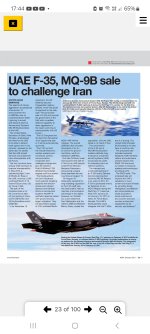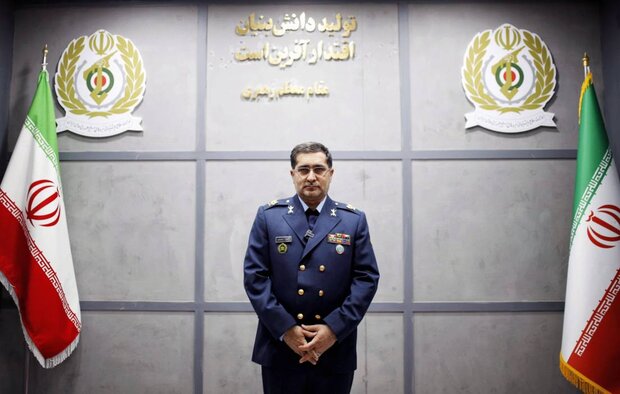Fatman17
THINK TANK: CONSULTANT
- Apr 24, 2007
- 37,389
- 43,760
- Country of Origin

- Country of Residence

The report further stated that the proliferation of armed Iranian UAVs to Iran’s allies and proxy forces in the region was “a challenge to American interests in the Middle East, including those of US allies and partners”. Further, Brookes stated that in the possession of nonstate actors “Iranian UCAVs or variants increase the range of the conventional and unconventional threats these groups pose.”

Small- and medium-sized platforms, such as the Mohajer-6, make up the majority of Iran’s UAV fleet
Ali Naderi
In January 2021, the US moved to impose additional sanctions on Iranian entities for what it said were actions related to conventional arms proliferation. In a prepared statement, Michael Pompeo, then US Secretary of State, said that such actions posed a “persistent threat” to regional and international security, pointing to Tehran’s support and “confirmed arms transfers” that fuelled ongoing conflicts in Syria, Lebanon, Iraq and Yemen.
The US had earlier announced, in September 2020, Executive Order 13949, which would “hold accountable those actors who seek to abet Iran in supporting armed groups in the region with weapons and arms materiel” – the first of which was the Iranian Ministry of Defence and Armed Forces Logistics (MODAFL), and Iran’s Defence Industries Organisation (DIO).
In the January 2021 announcement, Iran’s Marine Industries Organisation (MIO), Aerospace Industries Organisation (AIO), and the Iran Aviation Industries Organisation (IAIO) were designated as entities that engaged in activities that “materially contribute to the supply, sale, or transfer, directly or indirectly, to or from Iran, or for the use in or benefit of Iran, of arms or related materiel, including spare parts,” Pompeo detailed.
Continuing, Pompeo said that the MIO, AIO and IAIO “manufacture lethal military equipment for Iran’s military, including the [IRGC]” detailing that the equipment included “attack boats, missiles, and combat drones”, which provided “a means for the Iranian regime to perpetrate its global terror campaign.”
Strength assessment
In an analysis of Iran’s missile and UAV capabilities published by the International Institute for Strategic Studies (IISS) in April, it was detailed how Tehran has, over the decades, worked to improve unmanned capabilities in a bid to gain strategic influence. Indeed, the regime viewed its

The Shahed-191 clearly resembles the US RQ-170 surveillance UAV, one of which was captured by Iran
Ali Naderi
missile and unmanned systems as being a critical element of its wider defence posture.
“Iran is expanding its capacity to strike across the region through the continuing development and introduction of armed UAVs and cruise missiles,” explained Mark Fitzpatrick, IISS associate fellow and former executive director of IISS–Americas during an April 26 webinar. “Lacking a modern air force, Iran views missiles and UAVs as vital to its defence – under no circumstances will it give them up.”
Not only has the force been steadily developed over the decades, there are suggestions that its unmanned platforms have been used in active operations against targets outside of Iran, including the September 2019 attack on Saudi Arabia’s Abqaiq oil facilities, purportedly carried out by Iran-backed Houthi forces.
“The 2019 attack on the Abqaiq refinery, though claimed by the Houthis, contained the combined and co-ordinated use of direct attack UAVs and cruise missiles, which suggests strongly that Tehran had planned and carried out the attack,” stated Douglas Barrie, IISS senior fellow for military aerospace, during the April webinar.

The Ababil-3 has undergone an extensive redesign from its predecessor, to include new strike and surveillance capabilities
Ali Naderi
In addition, Barrie described a “range of small and medium-weight UAVs” currently in Tehran’s inventory, with the introduction of a new heavy UAV thought to be pending. He added that although the fleet was initially developed to fulfil an ISR role, this had since expanded into armed and direct attack UAVs.
The IISS report also revealed that Iran uses four strategies to provide nonstate actor allies with technology such as UAVs, rockets and ballistic missiles: direct transfers, upgrades to existing missiles and rockets, transfer of production capabilities, and provision via third parties.
Given this, and the growing ability of Iran to develop, field and distribute technology such as UAVs to proxies in the region, coupled with unmanned and missile technology, its ability in this field should be taken seriously.
With the developmental history and intention to use a capability that, in years to come, will form a central element to the future battlespace, the country appears to have a military edge over many of its regional rivals and, potentially, their superpower ally.

More of Tehran’s UAVs now feature a strike capability, such as the Mohajer-6, seen here with a Qaem smart munition fitted
Ali Naderi
Checking In
In the wake of the Nagorno- Karabakh conflict, how do you predict unmanned systems will change the battlefields of the future?
Share your view at: [email protected] under the subject heading Checking In.


Small- and medium-sized platforms, such as the Mohajer-6, make up the majority of Iran’s UAV fleet
Ali Naderi
In January 2021, the US moved to impose additional sanctions on Iranian entities for what it said were actions related to conventional arms proliferation. In a prepared statement, Michael Pompeo, then US Secretary of State, said that such actions posed a “persistent threat” to regional and international security, pointing to Tehran’s support and “confirmed arms transfers” that fuelled ongoing conflicts in Syria, Lebanon, Iraq and Yemen.
The US had earlier announced, in September 2020, Executive Order 13949, which would “hold accountable those actors who seek to abet Iran in supporting armed groups in the region with weapons and arms materiel” – the first of which was the Iranian Ministry of Defence and Armed Forces Logistics (MODAFL), and Iran’s Defence Industries Organisation (DIO).
In the January 2021 announcement, Iran’s Marine Industries Organisation (MIO), Aerospace Industries Organisation (AIO), and the Iran Aviation Industries Organisation (IAIO) were designated as entities that engaged in activities that “materially contribute to the supply, sale, or transfer, directly or indirectly, to or from Iran, or for the use in or benefit of Iran, of arms or related materiel, including spare parts,” Pompeo detailed.
Continuing, Pompeo said that the MIO, AIO and IAIO “manufacture lethal military equipment for Iran’s military, including the [IRGC]” detailing that the equipment included “attack boats, missiles, and combat drones”, which provided “a means for the Iranian regime to perpetrate its global terror campaign.”
Strength assessment
In an analysis of Iran’s missile and UAV capabilities published by the International Institute for Strategic Studies (IISS) in April, it was detailed how Tehran has, over the decades, worked to improve unmanned capabilities in a bid to gain strategic influence. Indeed, the regime viewed its

The Shahed-191 clearly resembles the US RQ-170 surveillance UAV, one of which was captured by Iran
Ali Naderi
missile and unmanned systems as being a critical element of its wider defence posture.
“Iran is expanding its capacity to strike across the region through the continuing development and introduction of armed UAVs and cruise missiles,” explained Mark Fitzpatrick, IISS associate fellow and former executive director of IISS–Americas during an April 26 webinar. “Lacking a modern air force, Iran views missiles and UAVs as vital to its defence – under no circumstances will it give them up.”
Not only has the force been steadily developed over the decades, there are suggestions that its unmanned platforms have been used in active operations against targets outside of Iran, including the September 2019 attack on Saudi Arabia’s Abqaiq oil facilities, purportedly carried out by Iran-backed Houthi forces.
“The 2019 attack on the Abqaiq refinery, though claimed by the Houthis, contained the combined and co-ordinated use of direct attack UAVs and cruise missiles, which suggests strongly that Tehran had planned and carried out the attack,” stated Douglas Barrie, IISS senior fellow for military aerospace, during the April webinar.

The Ababil-3 has undergone an extensive redesign from its predecessor, to include new strike and surveillance capabilities
Ali Naderi
In addition, Barrie described a “range of small and medium-weight UAVs” currently in Tehran’s inventory, with the introduction of a new heavy UAV thought to be pending. He added that although the fleet was initially developed to fulfil an ISR role, this had since expanded into armed and direct attack UAVs.
The IISS report also revealed that Iran uses four strategies to provide nonstate actor allies with technology such as UAVs, rockets and ballistic missiles: direct transfers, upgrades to existing missiles and rockets, transfer of production capabilities, and provision via third parties.
Given this, and the growing ability of Iran to develop, field and distribute technology such as UAVs to proxies in the region, coupled with unmanned and missile technology, its ability in this field should be taken seriously.
With the developmental history and intention to use a capability that, in years to come, will form a central element to the future battlespace, the country appears to have a military edge over many of its regional rivals and, potentially, their superpower ally.

More of Tehran’s UAVs now feature a strike capability, such as the Mohajer-6, seen here with a Qaem smart munition fitted
Ali Naderi
Checking In
In the wake of the Nagorno- Karabakh conflict, how do you predict unmanned systems will change the battlefields of the future?
Share your view at: [email protected] under the subject heading Checking In.










